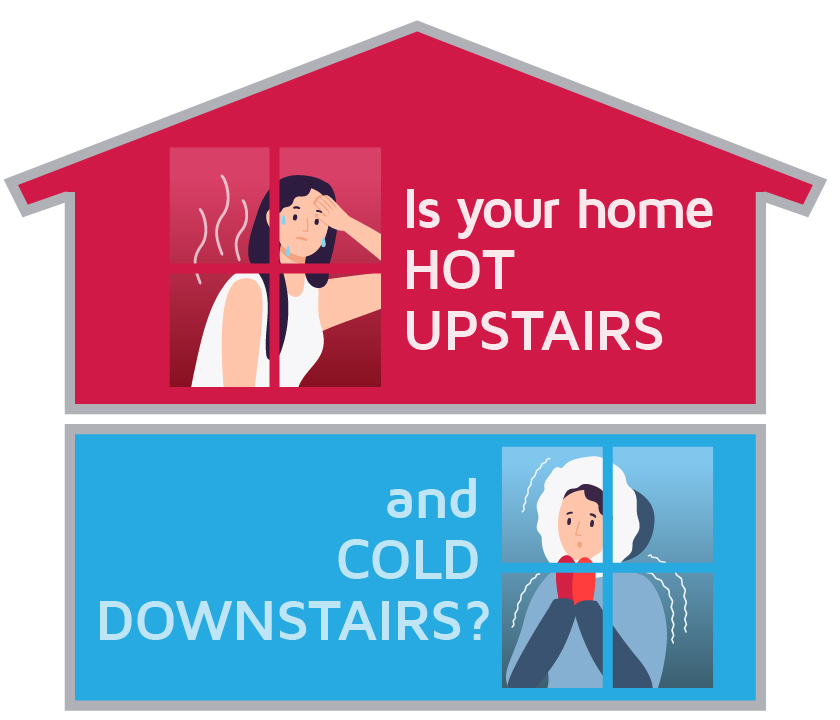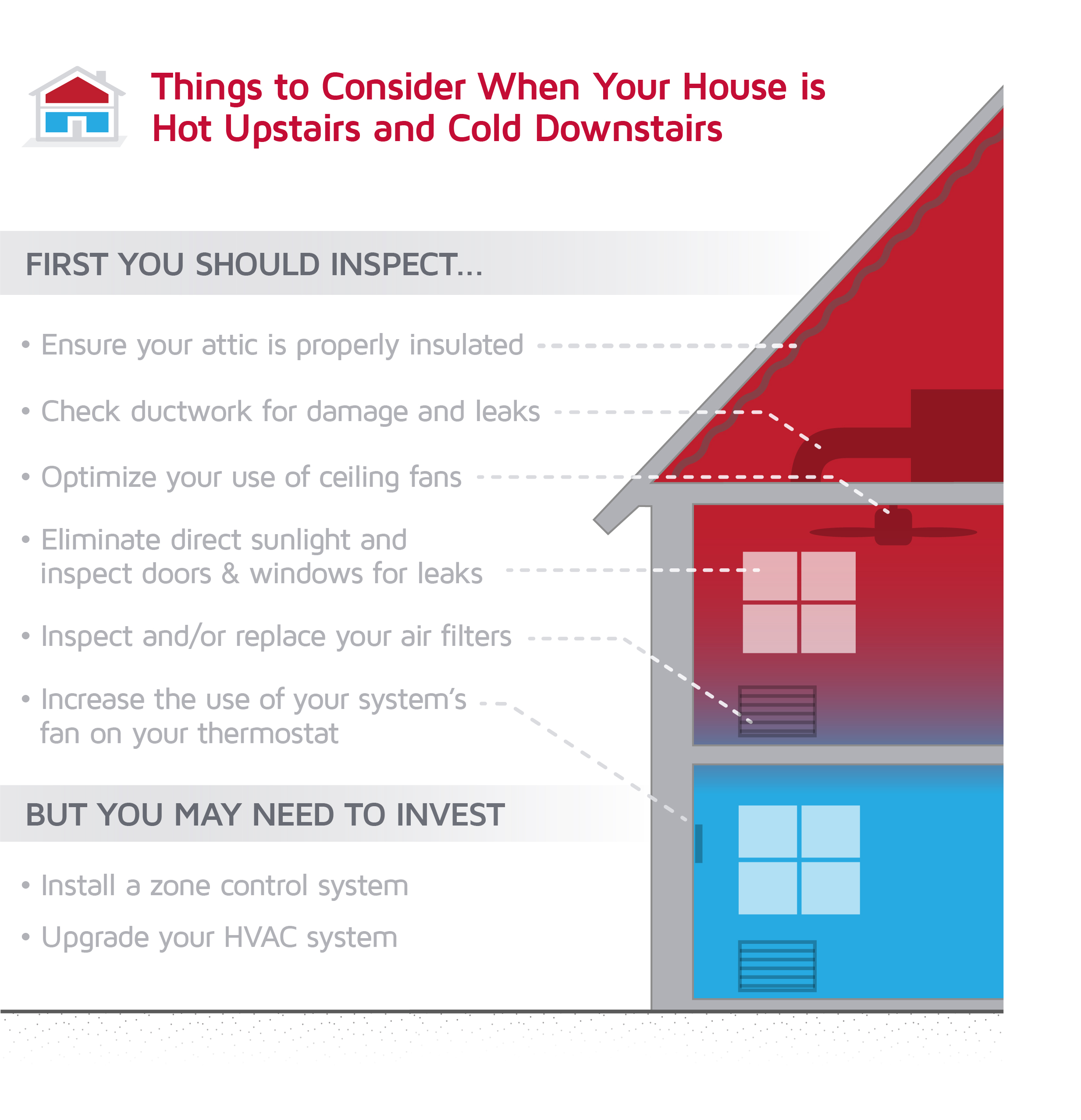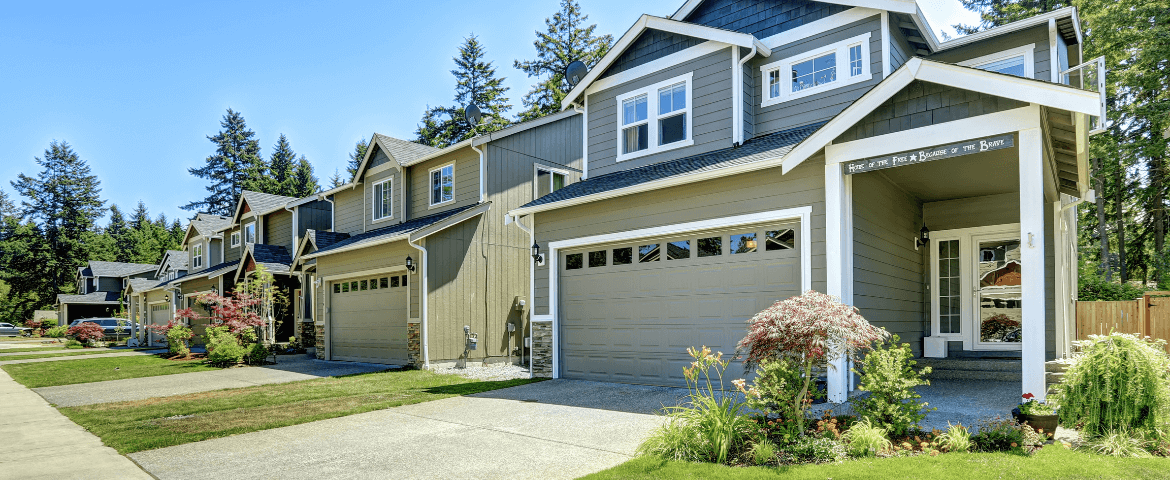Solving the Issue of Uneven Temperatures
If you rent or own a two-story home, you’re probably familiar with the seemingly impossible goal of getting your second floor as cool as the first.
It’s actually a common issue, especially for those living in areas with particularly warm summers or cold winters. There are many reasons  why even homes equipped with properly sized AC units have issues with a warm, humid second floor.
why even homes equipped with properly sized AC units have issues with a warm, humid second floor.
It seems logical that your central heating and air conditioner system would cool your entire home, right? Isn’t that what central air does?! In a perfect one-story world, that might be the case. Two story homes present challenges to a standard central HVAC system – challenges that aren’t always addressed by the builder or the previous installer.
Let’s go through some reasons for this inconvenience and some things you can do about it.
Why is the second floor warmer then the first?
First, we should recognize that science is the root cause of this issue. According to the laws of physics, warmer air rises. So, in its natural state, with no air conditioning, your home would almost always be warmer upstairs than downstairs. In a taller, two-story home, that constant battle with nature can make an air conditioners job a bit more complicated.
Beyond the science, there are a number of other contributing factors that can make winning that battle even more difficult.
Insufficient Insulation Upstairs or in Your Attic
Without proper insulation your conditioned air can seep through the cracks, rising into your attic and escaping the home, reducing the effectiveness of your system in those areas.
Improper insulation can also contribute to higher upstairs temps when your home roof is in direct sunlight. Roofing material can reach temperatures as high as 140º in the heat of summer, warming the air in the attic and upstairs living areas.
Lack of Airflow or Ventilation
Even with the best insulation, if your upstairs doesn’t have good air flow or your attic isn’t properly ventilated, all that rising warm air can end up trapped in the upper parts of your home. Circulating that air throughout your home and through the HVAC system is key to bringing down temps and reducing humidity upstairs.
An Aging or Inefficient HVAC System
Every HVAC system becomes less efficient over time. Even the best systems have an average lifespan of between 15 and 20 years. Yours may have been just right for your home when it was fresh, but if it’s nearing that expected lifespan, it may simply be struggling to maintain whole home temperatures.
This inefficiency could also be a symptom of an inadequately designed system. If the builder or previous owner opted for a single-zoned system, installed inadequate ventilation, or failed to explore beneficial upgrades like dampers your air conditioner may be struggling.
Faulty Ductwork
Your ductwork is trusted with carrying conditioned air throughout your home and can play a major role in upstairs/downstairs temperature inconsistencies. Old or leaky ductwork can let conditioned air to escape into your attic, crawl space, or basement and allow untreated air into your home, reducing the effectiveness of your system.
Poorly or improperly installed ductwork can also be a factor. Proper connection and duct sizing are critical to achieving adequate and efficient airflow throughout a home.
Dampers that Need Adjustment
If your home has only one thermostat, it technically has a single-zone system. But many two-story homes with single-zone HVAC systems include manually adjustable dampers. A damper is a valve-like mechanism installed inside your ductwork or ventilation unit. Preset by the installer, they help balance the air flow throughout the home.
As a system’s efficiency drops over time, or during particularly extreme weather conditions, these older damper settings can become ineffective. Inspect your ductwork to determine if you have dampers. Manual dampers are usually easily identifiable as a section of metal tubing with an adjustment lever that is installed in line with your ductwork. This lever will allow you to adjust the air flow through the duct where the damper is installed. Slightly reducing your downstairs air flow and/or increasing the flow to your upstairs vents can help to reduce the temperature discrepancies throughout your home.
Tips for Cooling Down Your Second Floor.
Fortunately, there are some things you as a homeowner can do to help reduce the uneven temperature issues within your home. Some may even qualify as DIY improvements.
Check and Change Your Filters
Yes, even a dirty air filter can contribute to uneven cooling. Clogged filters can slow air circulation and make your system work longer and harder to do its job. Fresh filters will eliminate any blockage your system may be fighting – making its two-story task a little easier.
Install Ceiling Fans
Adding ceiling fans to upstairs rooms can help get the air moving and improve second floor circulation. Within each space, they work to pull warmer air down from the ceiling, helping to equalize overall temperatures – reducing the burden on your system and improving its efficiency.
Reduce Incoming Direct Sunlight
Upstairs windows can let in sunlight and ambient heat raising the second-floor temperature. Minimizing incoming light and heat with drapes or other window coverings can help reduce that increase.
Run Your System's Fan More
During periods when the temperature differences become an issue, using your thermostat setting to keep the system fan on, even when the air conditioner or furnace aren’t engaged can ensure the air keeps moving. Even without active heating or cooling, the simple act of circulation can help equalize the temperatures across both floors and the whole home.
If you don’t have one, a programmable thermostat can help make the job of maximizing your homes airflow easier – optimizing temperature settings and setting timers to run your system’s fan periodically. Lennox offers a complete line of smart thermostats to help you take control of your air.
Install an Exhaust Fan in the Attic
During the warmest months of summer, an exhaust fan can evacuate trapped heat and humidity from your attic. With attic temperatures climbing well above even the outside temperature, a properly installed fan can reduce the temperature in your attic by as much as 40º.

We should mention that one thing you shouldn’t do is close or partially close the downstairs vents in an attempt to push more air upstairs. By design HVAC systems are meant to operate with full ventilation, and a properly installed system is balanced for the home it’s in. Closing those vents will only throw that balance off and cause your system to have to work harder.
Improving Airflow and Ductwork Efficiency
As we stated, there are a number of things you can do to help equalize your upstairs and downstairs air. But if the problem persists, you’ll need to connect with a local HVAC dealer or technician to take the next steps. Discuss your uneven cooling issue with them and they will suggest some options for addressing the problem.
Generally, a standard system service and inspection will allow them to assess your equipment and suggest a few ways to reduce or eliminate the problem.
Clean, Repair or Replace Ductwork
If you’re having uneven cooling or temperature discrepancies throughout your home, the odds are you may need some ductwork repairs. Typical residential ductwork – known in the industry as “Flex” or flexible duct, is made from an inner wire coil covered in a lightly insulated layer of plastic or foil. While the coiled wire gives it great flexibility as the name would suggest, its construction doesn’t make it very durable.
During a standard maintenance service your technician will inspect your ducts for damage an any other issues that might be contributing to the temperature differences. If there are repairs or replacement part they recommend, they will let you know in their inspection report.
Upgrade to a Multi-Zone System
Zoning involves equipment designed to divide your home into two or more spaces that can be controlled and cooled separately. It requires professional installation and design to ensure it works properly.
To create a multi-zoned system, dampers are added to your ductwork system. A damper is a device installed in the path of the air that acts like a valve, opening and closing incrementally to adjust the air flow to a given space. They allow you to fine tune each zone based on comfort preference, the number of windows within the space, proximity to the sun or other factors.
Though dampers can be manual or electric, in a modern zoned system, the dampers specific to each zone are controlled by a thermostat specific to that zone, giving you the ability to regulate each zone independently.
Lennox offers a full complement of zoning parts and equipment including a variety of zone-specific thermostats and sensors designed to work with your main smart thermostat.
Upgrade Your Existing System
If it turns out your issue stems from an aging system, you’ll need to look into replacing it. Reach out to an HVAC professional to perform a load test on your home. Once they’ve fully assessed your space, they will advise you on appropriate replacement options that will handle your entire home – including that second story.
Consider a Mini-Split
If your current system is old, it may just be inadequate for the job. Rather than go through the inconvenience and cost of replacing your entire HVAC system, you may consider adding a mini-split system to your upstairs space. Ductless mini-splits are smaller, simpler systems designed for spaces where ductwork is inconvenient or not feasible. They are ideal for cooling relatively small spaces or enhancing the cooling capacity of existing systems. Installation is very simple, and once installed, the units are highly efficient.
Strategically adding a mini-split to the second floor to help cool one or more of your upstairs spaces may be a quick and easy way to balance your temperatures and increase your indoor comfort.
Contact a Pro to Help You Tackle Your Temperature Imbalance
Again, schedule a professional maintenance inspection to shore up any issues you may have with your ductwork. This may go a long way toward correcting the imbalance within your home. If a bigger solution is needed, your technician can go over zoning options for your home.
If you suspect there are issues with your attic’s insulation or ventilation, we recommend you have an inspection done by an appropriate building professional. Your HVAC technician may be able to recommend the right person for the job.
Achieving whole home comfort in a two-story house can be done. If you’re frustrated with uneven cooling in your home, do a walk through and see if any of the things we mentioned here in this article might be contributing. Shore up the things you can handle on your own, and if the problem persists, locate a local Lennox pro to help get your two-story home back on the road to perfect air.

